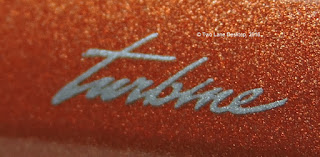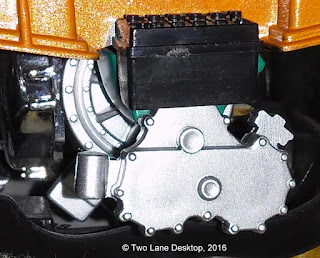Yatming 1:18 1963 Chrysler Turbine Car
A few years ago I profiled the Hot Wheels version of the 1963 Chrysler Turbine car alongside the Knight Rider KITT as both sported a turbine motor under the hood. My fascination still continues for the classic Chrysler Turbine car so much that I finally won an auction for the 1:18 scale version by the discontinued Yatming version. To be honest I never knew Yatming made a replica of this car so I was thrilled to finally see one, but after waiting for a good deal and an easy auction I finally got one. Of course, when it arrived it was in a box and on a base, but it was on the base backwards and despite the fact that it was displayed but never out of the box I doubted that. Then again after cleaning up many vehicles in the past with success it was time to do the same to this one. The end result is that the car now comes alive with all the glitz and glamor. Let's take a closer look at the Turbine car in a larger scale:
Click Here for Photo Gallery
The car starts with the gorgeous bronze color that makes this car look good and very unique from anything else when it was introduced in 1963. The body was designed and built by Ghia of Italy and sent over to Detroit where it was married with the chassis and turbine motor, all assembled by hand, to create 55 finished examples for experimental purposes with the select few of the general public. Elwood Engel designed this car after he departed from Ford where he put the finishing design touches on the 1963 Thunderbird, so there's no mistaken that the Turbine car looks a lot like the Thunderbird from some angles. When I got this car it was pretty dusty and that dust managed to make the car look dull, especially the chrome parts. After a disassemble, quick cleanup, dry time, and reassemble with rubber and plastic parts coated with Armor All the car now shines like new and the chrome really pops out. The vinyl top is part of the plastic windows and has a nice pattern to it, but you wouldn't really notice the plastic design unless you look up close.
Click Here for Photo Gallery
The front has the round headlights nestled in the turbine fin chrome housing, signal lights below, chrome grille that flows back as it goes toward the bottom of the vehicle (no bumper here), Turbine by Chrysler badge on the edge of the hood, and a center chrome strip with the turbine hood ornament. Chrome is neverending as it stretches from the top of the beltline with a chrome strip to the lower rocker panel with a larger and smoother panel. The top strip between the door gaps does make it look like the casting suffers from the banana-bent chassis look, but really it's just the way the chrome strip was applied. Also found are the Chrysler badges and front vents on the front fenders, Turbine badge on the rear fenders (originally this car was supposed to be called the Typhoon), and color-matching and chrome hubcaps (note the turbine shaped center cap) on white-wall tires. The chrome escapade never ends as more chrome surrounds the window trim and top, while the back-end has two taillight panels, with chrome surrounds, that cave inwards to create a jet-like look from the rear also aided by the reverse lamps coming out of the taillight coves. Then the center chrome section starts where the Chrysler corporation logo starts and smoothly flow to the bottom to meet with the Turbine plate, and if you look lower you can see the large rectangular exhaust pipes that expel the turbine gases.
Click Here for Photo Gallery
The trunk opens up to show the full-size spare tire, but the only way you can remove it is if you disassemble the vehicle to get access to the Phillips-head screw below the trunk. The doors open up to a color-matching interior for four with bucket seats featuring chrome strips and chrome backing plate on the front seats. Rear seats get less chrome, but a silver strip along the rear dash panel does show some chrome parts. The door panels front and rear feature a silver strip that houses the controls for the power windows and door locks on the front doors. A nice feature that I notice when apart was the front and rear windows are rolled down, but you can see the glass between the door panels: it looks like a poorly-done open gap at first, but it is a clear window piece to reflect the down windows. The center console has a flowing chrome turbine tube that flows from the front to the rear, and with it comes a covered slot between the front seats and a rising hump that houses the transmission shift lever, parking brake with chrome tube, and toggle switches for the heater, lights, and wiper blades. The lower part of the dash on the passenger-side has a silver trim piece with a black upper section where you will find radio controls and just below that one of the world's largest in-dash ashtray's!
Click Here for Photo Gallery
The driver sits behind a two-spoke steering wheel with chrome two-spoke inner rim, which is also behind three large gauges: The center one is the 120 mph speedometer, fuel gauge in the center, and odometer. The left-one houses the auxiliary gauges, while the right-one has the tachometer where idle rests at 14,000 rpm and a clock inside the tach. Alright, now to the good stuff as the hood opens to reveal the turbine motor: Chrysler A8301 turbine gas engine that produces 130 hp. and 426 Ib-ft of torque by using two turbines: one to spin the compressor at the front and the other to power the rear wheels. The black block is cast iron and hoses the turbines and the combustion chamber that uses only one spark plug to ignite any fuel, whether it would be gas, kerosene, diesel, jet fuel, tequila, or chanel no. 5, it would run on anything. However, leaded fuel at the time was not recommended because a concern that the lead in the gasoline could harm the turbine fins. The turbines also had stator blades that could move in different positions to provide increased power or block airflow to provide engine braking. The chrome covers on the ends are the rotating recuperators that transfer heat from the exhaust to pre-heat the incoming air to provide faster warm-up and better combustion and to lower exhaust temperatures, which was a concern in early turbine development.
Click Here for Photo Gallery
The engine needs a way to get compressed air to the motor when starting up, so that's when the separate compressor motor comes into play. This is the device located at the front of the engine that also houses the alternator and oil pump and filter to turn the compressor fan and provide current power and pressure for the turbine motor. The battery is located just above the compressor, which also is between the two large air filter covers. Additional details under the hood include the shock covers in black, the horn located to the left of the air box, and the brake fluid resovoir. The hood hinges are concealed from the interior footwells with a clever cover that resembles the vent boxes for the heater. The transmission is the three-speed Torqueflite automatic that has no bell housing for the torque converter because, well, the engine is the torque converter and typical torque converters have two turbine fins that spin with transmission fluid to move the vehicle, just like the turbine engine. You can see the transmission and the torque converter-less housing just below the vehicle, along with the oil pan, compressor motor, and lower A-arm suspension. The rest of the chassis looks familiar with the body-on-frame setup, driveshaft, live rear axle and leaf springs, and rear fuel tank of typical cars of that era, but with one difference: two huge silver exhaust tips from the engine to the rear of the vehicle to exhaust the turbine air more quickly, with lower temperature (equivalent to a gas motor's exhaust temperature) and free of carbon monoxide or harmful carbon or hyrdrocarbons. Oh, and the motor is air-cooled as it lacks any coolant system.
Click Here for Photo Gallery
When the car starts up the compressor spins in compressed air and fuel and the turbine whirs to life with a sound of a vacuum cleaner (most of that noise coming from the compressor). Spinning at 14,000 rpm at idle makes for rapid fuel consumption, one of the failures of this engine, but it idles smoothly and when you put your foot in the accelerator pedal the cars thrust to life (not as powerful as a fighter jet taking off) and the car moves off in a smooth fashion. There were a few problems with the motor over the testing trial period but overall the car ran flawlessly. Then Chrysler's financial problems started up and the expense and lack of any positive outcomes for the gas turbine compared with the internal combustion engine marked the end for the Turbine program. After the trial run was over 46 of the cars were destroyed because of liability purposes, six of them had the engines removed and were only for display, one owned by the Museum of Transportation in St. Louis, Missouri, and the last two owned by private collectors: Frank Kleptz and Jay Leno.
When the car was apart, close-ups of the engine:
Click Here for Photo Gallery
It's a beautiful car that is packed with lots of innovation and history, and while seeing the real car is like finding a needle in a haystack this Yatming 1:18 scale version provides the equivalent in a smaller size designed for your personal collection.
Click Here for Photo Gallery


















































Comments
Post a Comment